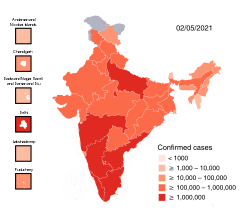- Total Confirmed cases by state and union territory
- Confirmed cases per million population by state and union territory
- Active cases by state and union territory
- Deaths per million population by state and union territory
- Deaths by state and union territory
- Recoveries per million population by state and union territory
Maps
Interactive maps
|
|
Click the play button in the top left to interact with the map.
Hover over the regions for values.
|
|
Click the play button in the top left to interact with the map.
Hover over the regions for values.





